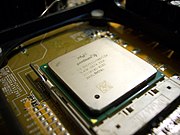In benchmark evaluations, the advantages of the NetBurst microarchitecture were not clear. With a carefully optimized application code, the first Pentium 4s did outperform Intel's fastest Pentium III (clocked at 1.13 GHz at the time), as expected. But in legacy applicationsfloating-point instructions, the Pentium 4 would merely match or even fall behind its predecessor. Its main handicap was a shared uni-directional bus. Furthermore, the NetBurst microarchitecture gave off more heat than any previous Intel or AMD microarchitecures. with many branching or x87
As a result, the Pentium 4's introduction was met with mixed reviews: Developers disliked the Pentium 4, as it posed a new set of code optimization rules. For example, in mathematical applications AMD's much lower-clocked Athlon (reaching a peak clock speed of 1.4 GHz) easily outperformed the Pentium 4, which would only catch up if software were re-compiled with SSE2 support. Tom Yager of Infoworld magazine called it "the fastest CPU - for programs that fit entirely in cache". Computer-savvy buyers avoided Pentium 4 PCs due to their price-premium and questionable benefit. In terms of product marketing, the Pentium 4's singular emphasis on clock frequency (above all else) made it a marketer's dream. The result of this was that the NetBurst microarchitecture was often referred to as a marchitecture by various computing websites and publications during the life of the Pentium 4.
The two classical metrics of CPU performance are IPC (instructions per cycle) and clock speed. While IPC is difficult to quantify (due to dependence on the benchmark application's instruction mix), clock speed is a simple measurement yielding a single absolute number. Unsophisticated buyers would simply consider the processor with the highest clock speed to be the best product, and the Pentium 4 was the undisputed megahertz champion. As AMD was unable to compete by these rules, it countered Intel's marketing advantage with the "megahertz myth" campaign. AMD product marketing used a "PR-rating" system, which assigned a merit value based on relative-performance to a baseline machine.

At the launch of the Pentium 4, Intel stated NetBurst-based processors were expected to scale to 10 GHz (which should be achieved over several fabrication process generations). However, the NetBurst microarchitecture ultimately hit a frequency ceiling far below that expectation — the fastest clocked Pentium 4 models reached a peak clock speed of 3.8 GHz and a maximum TDP of 115 W. Intel had not anticipated a rapid upward scaling of transistor power leakage that began to occur as the chip reached the 90 nm process node and smaller. This new power leakage phenomenon, along with the standard thermal output, created cooling and clock scaling problems as clock speeds increased. Reacting to these unexpected obstacles, Intel attempted several core redesigns ("Prescott" most notably) and explored new manufacturing technologies, such as using multiple cores, increasing FSB speeds, increasing the cache size, and using a shorter, more effecient pipeline along with lower clock speeds. Nothing solved their problems though and in 2003-05 Intel shifted development away from NetBurst to focus on the cooler-running Pentium M architecture. On January 5, 2006, Intel announced the Core processors, which put greater emphasis on energy efficiency and performance per clock. The final NetBurst-derived products were released in 2007, with all subsequent product families switching exclusively to the Intel Core microarchitecture.
For the mobile version of Pentium 4, Pentium 4-M models using a FSB of 400 MHz had TDPs in the range of mainstream mobile Core 2 Duo processors (20.8 W - 35 W), which is an acceptable amount. Although later Mobile Pentium 4 and Mobile Pentium 4 HT models using a 533 MHz FSB had a huge increase in TDP as Intel introduced faster-clocked processors. Intel eventually reached a speed barrier of 3.46 GHz with the Prescott core for Mobile Pentium 4 HT having a maximum TDP of 88 W, which is 23 W higher than the fastest-clocked desktop Core 2 Duo. Awkwardly, Intel launched the first Pentium M processors before they launched the first Mobile Pentium 4 microprocessors.
No comments:
Post a Comment